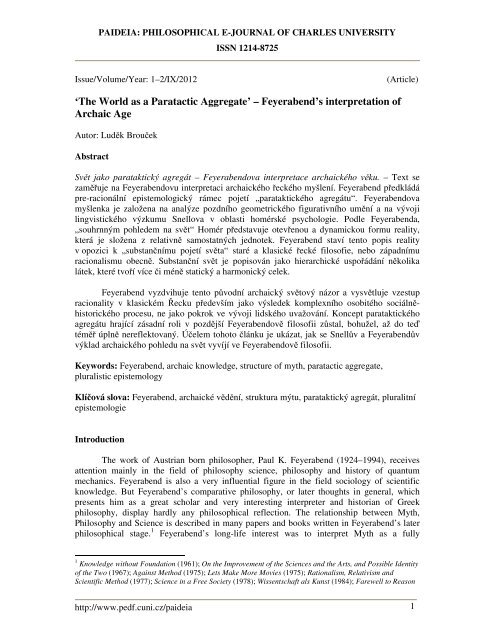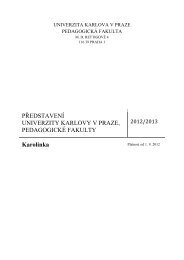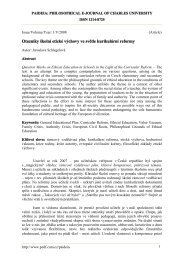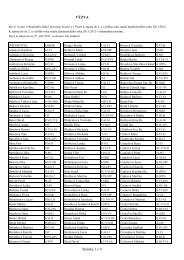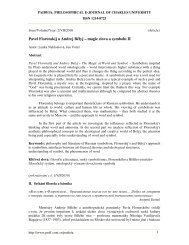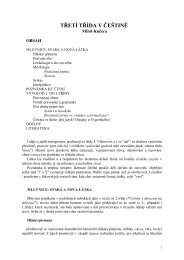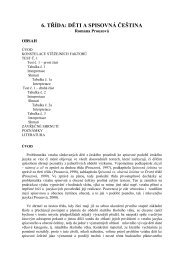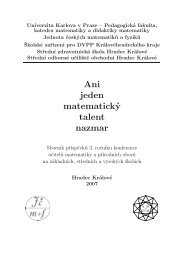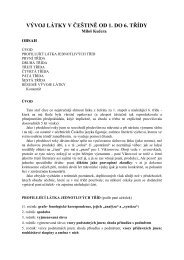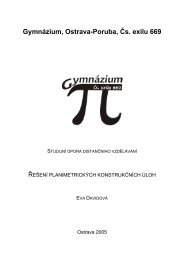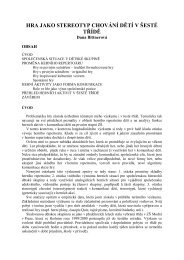Feyerabend's interpretation of Archaic Age
Feyerabend's interpretation of Archaic Age
Feyerabend's interpretation of Archaic Age
You also want an ePaper? Increase the reach of your titles
YUMPU automatically turns print PDFs into web optimized ePapers that Google loves.
Nr. 1EINFÜHRUNGSSEMINARIN DAS THEMA ATAXIEKlinische Bilder der Ataxie und ihre Behandlungsmöglichkeitenim Kontext der Posturalen KontrolleFachbereich:NeurologieNORDNNEUROLOGIEGGERIATRIEZielgruppe:Seminar-beschreibung:Kursleitung:Ergo- und PhysiotherapeutInnen mit demArbeitsschwerpunkt NeurologieEs werden im Seminar die klinischen Bilder der Ataxie imneurophysiologischen Kontext erarbeitet. Dazu wird sowohltheoretisch als auch praktisch die Bedeutung der PosturalenKontrolle, ihre Aspekte wie Core stability, Posturales Alignment,Posturaler Tonus, Posturale Orientierung vorgestellt. Am drittenTag wird anhand einer Patientendemonstration die therapeuti-sche Umsetzungsmöglichkeit vorgestellt. (UE/FP:23)Seminarschwerpunkte:• Befunderhebung• Praktische Arbeit im Kontext der Posturalen Kontrolle• Selbsterfahrung• PatientendemonstrationChristoph H<strong>of</strong>stetterPhysiotherapeut seit 1987, Bobath-Instruktor (IBITA), Weiterbildungenin Cyriax, Or<strong>of</strong>aziale Therapie nach K. Coombes, Wahr-nehmungskurse bei Affolter, Bisch<strong>of</strong>sberger und Sonderegger,Neuropsychologie-Kurse der GNP, Feldenkrais, seit 2000 selbst-ständig in eigenem Therapiezentrum, Dozententätigkeit u.a. ander Universität Marburg (2003-2006) und auf KongressenPPSYCHIATRIEPPÄDIATRIEFFACHÜBERGREIFENDOORTHOPÄDIETermin:1Kurs 101.10. – 03.10.2010Fr09.00 – 17.00 UhrSa 08.30 – 17.00 UhrSo 08.30 – 16.00 UhrOrt:Investition: 420 €Eigene Literatur:imPuls NORDHamburg-Altona, imPuls Stellwerk, S. 112H. Viebrock, B. Forst: Lehrbuch:„Bobath – Aktuell“, Thieme Verlag 10/ 2007, Christoph H<strong>of</strong>stetter ist Co-Autor für die klinische Arbeit des Bobath Konzepts im Erwachsenen BereichKKOMMUNIKATIONGGANZHEITLICH(SELBST)COACHING7
PAIDEIA: PHILOSOPHICAL E-JOURNAL OF CHARLES UNIVERSITYISSN 1214-8725a dangerous sea voyage home after the Trojan War. The original poem was composed in anoral tradition by rhapsodists (pr<strong>of</strong>essional performer), and was more likely intended to besung than read.The aim <strong>of</strong> Feyerabend’s analysis is to present remarkably parallel features <strong>of</strong> archaicvocabulary, syntactical grammar, literary style, pre-scientific and pre-philosophical thoughts,and various kinds <strong>of</strong> visual art. Feyerabend claims that these features advert to fullydeveloped world-view <strong>of</strong> <strong>Archaic</strong> man. Feyerabend calls Greek <strong>Archaic</strong> world-view the‘paratactic Aggregate’.The term parataxis was introduced to scientific nomenclature, by the Germanphilologist Friedrich Thiersch in his Greek Grammar, <strong>of</strong> 1831. Thiersch examined 12different dialects in Greek Language from Epic to Romaic (Modern Greek) and noticeda curiosity about lack <strong>of</strong> subordinate clauses in syntax <strong>of</strong> the earliest dialects, for example <strong>of</strong>Homer dialect. According to Thiersch, from this simple syntax <strong>of</strong> parataxis was developedmore sophisticated syntax <strong>of</strong> hypotaxis. The doctrine <strong>of</strong> parataxis was further stated by Langein his paper <strong>of</strong> 1852, and the word has since become an accepted syntactical term inopposition <strong>of</strong> term <strong>of</strong> hypotaxis. (Morris 1901: 113) Parataxis is <strong>of</strong>ten realized by one <strong>of</strong> theconjunctions and, so, either… or, neither …nor, but. The most common hypotacticconjunctions include if, while, because, when.From the beginning <strong>of</strong> discussions about parataxis there is some disagreement amonggrammarians and it is problematic to come through with a narrow definition <strong>of</strong> this term.A number <strong>of</strong> definitions have emerged, <strong>of</strong>ten conflicting but briefly parataxis gives what isgenerally known as a coordination, or juxtaposition, <strong>of</strong> two simple sentences, while hypotaxisrepresents subordination. Metaphorically these two terms could be expressed expressed, forexample as rail (parataxis) and ladder (hypotaxis). Parataxis is commonly thought as a kind <strong>of</strong>melting together <strong>of</strong> two independent sentences, placing side by side like beads on a string, andassociated with a stream <strong>of</strong> thought or a train <strong>of</strong> thought. A classic example <strong>of</strong> a paratacticsentence is Caesar’s boast as reported by the historian, Suetonius. Veni, vidi, vici. (Suetonius,Julius Caesar, sect. 37) “I came, I saw, I conquered.”Hypotaxis is mostly defined as the relation between a dependent element and itsdominant, the element on which it is dependent. Contrasting with this is parataxis, which isthe relation between two like elements <strong>of</strong> equal status, one initiating and other continuing.(Butler 2003: 260 cites Halliday 1994: 218)Linguists <strong>of</strong> the beginning <strong>of</strong> the 20 th century who observed paratactic sentences fromSanskrit, Greek and early Latin writers served the theory <strong>of</strong> evolutionary development <strong>of</strong>human language and regarded paratactic sentence-structure as a primitive stage <strong>of</strong>undeveloped human thought. “Order was gradually brought into the chaos <strong>of</strong> the mind, andman became able to correlate and classify.” (Wallin 1910: 10) Because the field <strong>of</strong> parataxisis wider in the spoken languages they presupposed that there is a discrimination tone and bysentence-accent which does suggest subordination. (Morris 1901: 123)Parataxis was detected as the main characteristic <strong>of</strong> compositional technique for preliteratearchaic cultures. As far as we can know it occurs in Mycenaean court poetry whichcan be traced to the poetry <strong>of</strong> eastern courts (Sumerian, Babylonian, Hurrian, Hethitic,http://www.pedf.cuni.cz/paideia 8
PAIDEIA: PHILOSOPHICAL E-JOURNAL OF CHARLES UNIVERSITYISSN 1214-8725Phoenician). This style was developed from highly formal royal correspondence. (Webster1977: 207) As paratactic composition significantly appears in Homeric epic poems it isintroduced in theory <strong>of</strong> oral-formulaic composition in 1920s by Parry and Lord (see forexample Parry 1971; Lord 1960; Foley 1988). Parataxis heavily influenced written literatureafter Homer untill the fifth century Greek prose. Homer exhibited this stylistic phenomenonalso called ‘the adding style’ (Parry 1971) or ‘the cumulative technique’ (Kirk 1991).Feyerabend adopted Webster’s term ‘paratactic aggregate’ which combines Homer’s style andgeometric figure scenes. (Webster 1977: 207)Parataxis in Geometric artThe first scholar who documented difference between archaic-paratactic and classicalhypotacticstatuary was German specialist in ancient art, particularly sculpture, GerhardKrahner in 1931. Classical art attempts for realistic description <strong>of</strong> things and events withperspective, while archaic, formal art describes an event by the aggregation <strong>of</strong> elements. Theelements <strong>of</strong> such an aggregate are all given equal importance, the only relation between themis sequential, there is no hierarchy, no part is presented as being subordinate to anddetermined by others. (Feyerabend 2009: 117) The early art style is described as follows:“The early geometric system <strong>of</strong> decoration was elaborated in two ways: first bya structural alteration in the ornamental scheme-the division <strong>of</strong> the main zone by means <strong>of</strong>verticals into rectangular fields; and secondly by the introduction <strong>of</strong> animal and humanfigures… The chief animals are birds, horses, deer: the scenes are mostly battles, <strong>of</strong>ten at seaor on the seashore, and funerals. The figures are schematized silhouettes. The men, forexample, are very tall and thin, the trunk a triangle tapering to the waist, the head and a knobwith a mere excrescence for the face: towards the end <strong>of</strong> the style the head is lit up – the headknobis drawn in outline, and dot signifies the eye.” (Beazley, Ashmole 1932: 3)“The silhouettes present a number <strong>of</strong> postures: they stand, march, row, drive, fight,die, lament, etc. But always their essential structure must be clear, and this is one <strong>of</strong> thelegacies which remains in archaic and classical art.” (Webster 1977: 205)According to Webster, Attic Geometric art should not be called primitive, although itdoes not have the kind <strong>of</strong> photographic realism that literary scholars appear to demand inpainting. Webster argues that it is highly sophisticated art with its own conventions that serveits own purposes. Feyerabend gives as an example in his analysis <strong>of</strong> two pictures: a kid halfswallowed by lion and charioteer standing in a carriage. According to Feyerabend, thesepictures do not represent an illusory account <strong>of</strong> situation, but a visual catalogue, a list, whichis supposed to ‘read’ rather than ‘see’. The lists are organized sequentially; that is, the shape<strong>of</strong> an element does not depend on the presence <strong>of</strong> other elements. (Feyerabend 2009: 117–121)Lions are ferocious, kids are peaceful. The kid on the picture looks peacefully evenbeing swallowed by a lion because the picture ‘reads’: ferocious lion, peaceful kid,swallowing <strong>of</strong> kid by lion. A charioteer standing in the carriage is painted as standing abovethe floor by the purpose that everything can clearly be seen. The elements <strong>of</strong> the aggregatemay be physical parts, states <strong>of</strong> affairs or actions. Feyerabend maintains that these formalhttp://www.pedf.cuni.cz/paideia 9
PAIDEIA: PHILOSOPHICAL E-JOURNAL OF CHARLES UNIVERSITYISSN 1214-8725idea that the <strong>Archaic</strong> world-view prevails epistemological and ontological basis in dynamicparatactic aggregation <strong>of</strong> things and events. In his biography Feyerabend writes:“I still remember the excitement I felt when reading Snell on Homeric notion <strong>of</strong>human being. This was not a theory formulated to bring order into material that could standon its own feet; it was a set <strong>of</strong> habits that pervaded everything – language perception, art,poetry, as well as various anticipations <strong>of</strong> philosophical thought. Acting accordingly, the earlyGreeks seemed to live in a special and self-contained world.” (Feyerabend 1995: 140)Snell’s methodology was meant to explain Homer strictly his own terms. “The morecarefully we distinguish between the meanings <strong>of</strong> Homer’s words and those <strong>of</strong> the classicalperiod, the clearer grows our vision <strong>of</strong> the gulf which lies between the two epochs, and <strong>of</strong> theintellectual achievement <strong>of</strong> the Greeks.” (Snell 1953: 1)Expressions for operation <strong>of</strong> sight in HomerThe typical feature <strong>of</strong> archaic languages is their lack <strong>of</strong> abstraction. Homer’s languageuses a number <strong>of</strong> verbs for the operation <strong>of</strong> sight: horan, idein, leussein, athrein, theasthai,skeptesthai, ossesthai, derkesthai, paptainein. But only two verbs for seeing are used in thelanguage <strong>of</strong> antic Greece: blepein and theorein.Derkesthai is etymologically connected to dracon – ‘the seeing one’, the snake. Themeaning <strong>of</strong> this verb is to have a particular look in one’s eyes: to stare, to glare, or to glaze. InHomer, this is used as derkesthai <strong>of</strong> the Gorgon; <strong>of</strong> the eagle; <strong>of</strong> the Patroclus when Achillesblames him to look like crying girl who begs her mother to take her in her arms (i.e. 16.10);and <strong>of</strong> the Odysseus when missing his homeland in exile, his fixed glance continuallytravelled forth’ across the sea (Od. 5.84 and 158). Snell infers that Homer’s derkesthai refers,not so much to the function <strong>of</strong> the eye, as to its gleam as noticed by someone else.(Snell 1953: 2–3)Paptainein represents ‘looking about’ inquisitively, carefully, or with fear. Forpaptainein, as well as for derkesthai, there is no evidence <strong>of</strong> using it in the first person inHomer’s works. This mode <strong>of</strong> looking is noticed in others. According to Snell, paptaineindenotes a visual attitude, and does not hinge upon the function <strong>of</strong> sight as such.(Snell 1953: 4)Leussein is derived from leukos, which means gleaming or white, and the translation<strong>of</strong> the verb leussein is to see something bright. This verb, inspite <strong>of</strong> the previous two, appearsas leusso (first person sg.) and connotes certain sensations experienced in the act <strong>of</strong> seeing <strong>of</strong>specific objects like fire or shining weapons. Snell regards that this term too derives its specialsignificance from a mode <strong>of</strong> seeing; not the function <strong>of</strong> sight, but the object seen, and thesentiments associated with the sight, give the word its peculiar quality. (Snell 1953: 3)Ossesthai it means to have a threatening impression, and thus it approximates to themeaning ‘suspect’. Once more, as in the previous instances, Snell claims that the object andthe attending sentiment determine the seeing. Theasthai means to look with one’s mouth wideopen, i.e. ‘to gape’ or ‘stare’. This verb <strong>of</strong> sight bases its significance upon gesture andfeeling. (Snell 1953: 4)http://www.pedf.cuni.cz/paideia 11
PAIDEIA: PHILOSOPHICAL E-JOURNAL OF CHARLES UNIVERSITYISSN 1214-8725Theorein is a new verb in Ionic Greek derived from a noun: Theoros, its basic meaningis ‘to be a spectator’ like watching from the distance for example Olympic games. Soon,however, it came to mean: ‘to look on’, ‘to contemplate’ without reflecting an attitude or anemotion. The stress lies on the fact that the eye apprehends an object. Only theorein, togetherwith another later Ionic verb, idein, were further used in antic Greek in the meaning <strong>of</strong> the realsubstance <strong>of</strong> the operation known as ‘sight’. The others verbs disappeared except <strong>of</strong>paptainein, which survived in imperfective form as periblepesthai ‘to look around’ (Snell1953: 4).According to Snell, Homeric men took no decisive interest in what we justly regard asthe basic function, the objective essence, <strong>of</strong> sight; and if they had no word for it, it followsthat as far as they were concerned it did not exist. (Snell 1953: 4)Expressions for body in HomerThe word in fifth century Greek, which refers to the body, is soma. but alreadyAlexandrian scholar, Aristarchus, noticed, that in the Homer word soma is never used withreference to a living being; soma is the corpse. Aristarchus expressed the opinion that forHomer, demas was the live body. The expression demas: refers to a live body, but as Snellregards, only in the accusative <strong>of</strong> specification for example ‘His body was small’ appears inHomer, and ‘his body resembled a god’s’. It means ‘in structure’, ‘in shape’ such as: to besmall or to resemble someone. (Snell 1953: 5)Homer’s other expressions for ‘body’ are ‘limbs’; guia are the limbs as moved by thejoints, melea the limbs in their muscular strength. Snell gives many examples where limbswere translated as a body: ‘his body became feeble’; ‘his whole body trembled’; ‘sweatpoured from his body’ etc. (Snell 1953: 5)Chros, ‘the skin’ is other word in which Homer describes the whole body: ‘to washa body’ or ‘the sword pierced his body’. But according to Snell, chros is not a skin as ananatomical substance but the skin that can be peeled <strong>of</strong>f – that is derma – but the skin assurface, as the outer border <strong>of</strong> the figure <strong>of</strong> man, as the foundation <strong>of</strong> color, and so forth.(Snell 1953: 6) Snell sums up that among the early expressions designating what was laterrendered as soma or ‘body’, only the plurals guia, melea, etc. refer to the physical nature <strong>of</strong>the body; for chros is merely the limit <strong>of</strong> the body, and demas represents the frame, thestructure, and occurs only in the accusative <strong>of</strong> specification.Snell adds considerable account <strong>of</strong> examples from Homer for the presumption that theHomeric Greeks perceive body as a sum <strong>of</strong> limbs showing that Homer frequently speaks <strong>of</strong>fleet legs, <strong>of</strong> knees in speedy motion, <strong>of</strong> sinewy arms etc. Snell also saw that the same concept<strong>of</strong> human body, which contains Homeric language, appears on the vases <strong>of</strong> the geometricperiod. Man figures were painted with clearly distinguished limbs from each other with hugeunrealistic muscles, while the joints are on the other hand presented as extraordinarily thin.“As it is, early Greek art actually corroborates our impression that the physical body <strong>of</strong>man was comprehended, not as a unit but as an aggregate. Not until the classical art <strong>of</strong> thefifth century do we find attempts to depict the body as an organic unit whose parts arehttp://www.pedf.cuni.cz/paideia 12
PAIDEIA: PHILOSOPHICAL E-JOURNAL OF CHARLES UNIVERSITYISSN 1214-8725mutually correlated. In the preceding period the body is a mere construct <strong>of</strong> independent partsvariously put together.” (Snell 1953: 6)The unity <strong>of</strong> body was neither designated by words, nor perceived or known for theHomeric man. Man was perceived and described by the most conspicuous elements <strong>of</strong> hisappearance as the sum total <strong>of</strong> his limbs. As Sullivan summarizes, Snell’s demonstration thatthe early Greeks did not yet have a unitary concept <strong>of</strong> the body has been <strong>of</strong>ten criticized,corrected, supplemented, and refined, but not superseded, by later scholars. Snell’s view thatsoma only means the corpse follows for example, Vivante 1955; Herter 1957; Koller 1958;Krafft 1963. In opposition to this view <strong>of</strong> soma as a corpse state for example, Hirzel 1914;E. Bickel 1926; Harris 1960; West 1978; Renehan 1979. Sullivan argues that soma means“body” in Homer and can refer either to a living body or to a corpse. (Sullivan 1988: 2)Snell’s <strong>interpretation</strong> <strong>of</strong> Homeric “Soul” or “Mind”As Snell further demonstrates, the iliadic vocabulary lacks a single word for theconcept <strong>of</strong> soul, consciousness, or mind. This fact was treated in detail by many classicalphilologists <strong>of</strong> the past century (see Dodds 1951; Onians 1951; Fränkel; 1962; Adkins 1970;Bremmer 1987; Robinson 1989; Taylor 1989; Sullivan 1988; Caswell 1990; Griffin, 1980;Gaskin, 1990; Pelliccia, 1995; Clarke, 1999; Williams, 1993; Porter, 2006).According to Dodds, the <strong>Archaic</strong> concept <strong>of</strong> the soul was replaced in Greek witha new and revolutionary conception <strong>of</strong> the relation between body and soul appearing at theend <strong>of</strong> the <strong>Archaic</strong> <strong>Age</strong>. For Dodds, this new development was due to trade and colonizationthat had brought the Greeks in contact with the shamanistic culture <strong>of</strong> Black Sea Scythians inseventh century. (Dodds 2004: 136)In later Greek, the word for soul is psuche. For Homer, psuche is the force that keepsthe human being alive and it leaves its owner when he is dying, or when he losesconsciousness. The word psuche is akin to psuchein: ‘to breathe’. Homer says that the psucheis risked in battle when battle is fought for it because one wishes to save his psuche.(Il. 21.569) The psuche usually leaves the body through the mouth (Il. 9.409) or througha wound (Il. 14.518; 16.505). Bremmer distinguishes between two types <strong>of</strong> psuche in Homer:the free soul, which possessed no psychological attributes and was active only outside thebody, as in dreams, swoons, and the afterlife; and the body soul, which endowed a personwith life and consciousness. (Bremmer 1987: 8)The other words for the ‘mind’ that Snell elaborates are thumos and noos. Accordingto Snell, in Homer, thumos is the generator <strong>of</strong> (e)motion or agitation (joy, pleasure, love,sympathy, anger), while noos is the cause <strong>of</strong> ideas and images. (Snell 1953: 9) Thumos, themental organ that provides motion for the bones and limbs leaves the limbs at the point <strong>of</strong>death, but thumos does not continue to exist after death unlike psuche, which goes down toHades. The death <strong>of</strong> an animal is described in Homer also by loosing thumos – the death <strong>of</strong>a horse (Il. 16.469), <strong>of</strong> a stag (Od. 10.163), <strong>of</strong> a boar (Od. 19.454) or <strong>of</strong> a dove (Il. 23.880).According to Snell, it is evident that people were averse to ascribing the psuche thata human being loses when he dies, also to an animal. They therefore invented the idea <strong>of</strong>a thumos which leaves the animal when it expires. (Snell 1953: 10) Caswell enlargedhttp://www.pedf.cuni.cz/paideia 13
PAIDEIA: PHILOSOPHICAL E-JOURNAL OF CHARLES UNIVERSITYISSN 1214-8725categories <strong>of</strong> function <strong>of</strong> thumos to – loss <strong>of</strong> consciousness – death, the cognitive orintellectual function, the emotional function, the deliberative function and the function <strong>of</strong>motivation. For Caswell thumos was either the blowing breath or the flowing blood. (Caswell1990: 25)Noos is akin to noein which means ‘to realize’, ‘to see in its true colors’; and <strong>of</strong>ten itmay simply be translated as ‘to see’, but it stands for a type <strong>of</strong> seeing which involves notmerely visual activity but the mental act which goes with the vision. As Snell says: “It is themind as a recipient <strong>of</strong> clear images, or, more briefly, the organ <strong>of</strong> clear images.” (Snell1953: 12) The noos <strong>of</strong> Zeus is ever stronger than that <strong>of</strong> men. (Il. 16.688) However, Snellnotices that there is no clear distinction between noos and thumos, and they overlap in manycases. In Homer there can be found examples for knowing something by emotion (thumos) orto have a joy as a mental reflection. Agammenon rejoiced in his noos when Achilles andOdysseus quarreled with each other for the distinction <strong>of</strong> being the best man. (Od. 8.78)Snell discussed the concept <strong>of</strong> ‘soul’ and ‘mind’ mainly by the notions <strong>of</strong> psuche,thumos and noos. After Snell, other scholars continued to analyze additional psychic entities,which, in Homer, carried emotional and mental activity – phrenes or prapis – presumably theinflating lungs and etor, kradie, ker: heart. (Sullivan 1988: 196)These mental events are not necessarily private and may belong to a differentindividuals altogether. Snell and many other scholars argues that, in Homer, we never finda personal decision, a conscious choice made by an acting human being. Even where a hero isshown pondering two alternatives, the intervention <strong>of</strong> the gods plays the key role. Mental andspiritual acts are due to the impact <strong>of</strong> external factors, and man is the open target <strong>of</strong> a greatmany forces that impinge on him, and penetrate his very core. (Snell 1953: 20) Onians saysthat Homer’s heroes, with all their magnificent vitality and activity feels themselves at veryturn not free agents but passive instruments or victims <strong>of</strong> other powers. (Onians 1988: 303)“A man felt that he could not help his own actions. An idea, an emotion, an impulsecame to him; he acted and presently rejoiced or lamented. Some god had inspired or blindedhim.” (Onians 1988: 303)Hermann Fränkel has aptly termed the Homeric man “ein <strong>of</strong>fenes Kraftfeld” an “openfield<strong>of</strong> energy”, that divine forces can readily enter or leave. (Sullivan 1988: 9) Feyerabendspeaks about the Homeric man conceptually and optically like rag dolls and functioning astransit station for events (ideas, dreams, feeling). “[H]e finds himself involved in one seriesactions rather than in another and his life develops accordingly.” (Feyerabend 1987: 97)“The heroes <strong>of</strong> the Iliad, however, no longer feel that they are the playthings <strong>of</strong>irrational forces; they acknowledge their Olympian gods who constitute a well-ordered andmeaningful world. The more the Greeks begin to understand themselves, the more they adopt<strong>of</strong> this Olympian world and, so to speak, infuse its laws into the human mind.” (Snell1953: 21)Homer has also many words for our term ‘force’ and the meaning <strong>of</strong> each <strong>of</strong> thesewords is precise, concrete, and full <strong>of</strong> implications; so far from serving as abstract symbols <strong>of</strong>force, as do the later term dunamis which may be used <strong>of</strong> no matter what function. (Snellhttp://www.pedf.cuni.cz/paideia 14
PAIDEIA: PHILOSOPHICAL E-JOURNAL OF CHARLES UNIVERSITYISSN 1214-8725On the other hand, this part <strong>of</strong> Homer used Dodds for explaining irrationality in earlyGreek. Agamemnon declares that it was not him who took Achilles’ mistress: “Not I was thecause <strong>of</strong> this act, but Zeus and my portion and the Erinys who walks in darkness: they it waswho in the asserably put wild ate in my understanding, on that day when I arbitrarily tookAchilles’ prize form him. So what could I do? Deity will always have its way.” (Il. 19.86)According to Dodds: “It would be a misunderstanding <strong>of</strong> the Greek concept <strong>of</strong> divinetemptation or infatuation (ate) to read these words <strong>of</strong> Agamemnon as a weak excuse orevasion <strong>of</strong> responsibility.” (Dodds 2004: 3)However, many other contemporary scholars and classicists disagree with Snell’sconcept. Gaskin contends that Homeric decision-making stands up as a fully self-conscious,autonomous activity. (Gaskin 1990) Or even more that Homeric Greeks are recognisablyunified selves, just like us. (Williams 1993) Pelliccia opposes to Snell’s view bydemonstrating that Homeric organs like thumos in Homer recognizes the functions peculiar tothem but subordinates them to the speaking person as parts <strong>of</strong> a whole. (Pellicia 1995: 27)Clarke seeks unitary concepts that are articulated in varying ways to produce a range <strong>of</strong>images. According to Clarke, relationship between mental life and the body in the Homericpoems is best characterised in terms <strong>of</strong> unity, (Clarke 1999: 12) whereas Porter assumes thatSnell’s approach is loaded by prejudices <strong>of</strong> German Romantism about the Homeric mind.(Porter 2006)Snell’s concept <strong>of</strong> paratactic aggregation <strong>of</strong> body and mind in Homer may beperceived as reductive, (Lateiner 2006) one-sided and an exaggerated explanation <strong>of</strong> Homericpsychology. On the other hand, Snell’s research and Feyerabend’s effort to aggregate allrelevant <strong>interpretation</strong>s <strong>of</strong> <strong>Archaic</strong> Greek supporting this view, indeed reveals some uniqueand significant aspect or archetype pattern <strong>of</strong> understanding the world.Feyerabend’s World <strong>of</strong> <strong>Archaic</strong> <strong>Age</strong> as a Paratactic AggregateAlready Snell attempts to describe the whole <strong>Archaic</strong> world-view and Feyerabendfurther develops the idea that <strong>Archaic</strong> man understood the entire world in the principles <strong>of</strong>paratactic aggregate as described above. For example, Feyerabend indicates paratactictreatment <strong>of</strong> events in the case <strong>of</strong> human motion when Achilles drags Hector along in the dust.(Il. 22.298) The process <strong>of</strong> dragging also contains the state <strong>of</strong> lying as an independent part,which together with other such parts, constitutes the motion. For the poet, time is composed<strong>of</strong> moments, similarly like Zeno argument <strong>of</strong> the arrow. (Feyerabend 1975: 180) The viewthat things, ideas, actions, and processes are agreggates <strong>of</strong> (relatively independent) partsbecomes clear, according to Feyerabend, also from funeral inscriptions, passages <strong>of</strong> comedy,sophistic debates or medical and historical treatises. (Feyerabend 1999: 38)The same is for world views. <strong>Archaic</strong> religion <strong>of</strong>fers an opportunistic eclecticism thatdoes not hesitate to add foreign gods to those already accepted. Greek myth is not one storybut an aggregate <strong>of</strong> many stories and myths (<strong>of</strong>ten foreign). According to Levi-Strauss, whatconstitutes a myth is not the individual versions, but all the versions together. These versionscan fundamentally, or in details, contradict to each other. For example, there are many places<strong>of</strong> birth and tombs <strong>of</strong> immortal gods. Such contradictions were not perceived as a problem in<strong>Archaic</strong> <strong>Age</strong>. It appears to be point <strong>of</strong> criticism in six century BC for Hecataeus and forphilosophers as Heraclitus and Xenophanes. Greek Pantheon was an aggregate <strong>of</strong> generationshttp://www.pedf.cuni.cz/paideia 16
PAIDEIA: PHILOSOPHICAL E-JOURNAL OF CHARLES UNIVERSITYISSN 1214-8725<strong>of</strong> gods where foreign gods were added as well (Apollo). Every God manifested a specialfield <strong>of</strong> being, which were all together in dialectical relation. The natural world is subdividedinto qualitatively different regions that are subjected to different laws. Poseidon says in Ilia’s15,187ff [Lattimore tr.]:…Since we are three brothers born by Rheia to Kronos,Zeus and I and the third is Hades, lord <strong>of</strong> the dead men.All was divided among us three ways, each given his domain.I when the lots were shaken drew the grey sea to live inForever; Hades drew the lot <strong>of</strong> the mists and the darkness,And Zeus was allotted the wide sky, in the cloud and the bright air.But earth and high Olympos are common to all three. ThereforeI am no part <strong>of</strong> the mind <strong>of</strong> Zeus. Let him in tranquilityAnd powerful as he is stay satisfied with his third share.The third generation <strong>of</strong> Olympic gods also gives a well-defined part <strong>of</strong> the world astheir field <strong>of</strong> action – for example, Artemis is Goddess <strong>of</strong> archery and hunting, Athena isgoddess <strong>of</strong> wisdom and war, Hephaestus is god <strong>of</strong> the forge, and Hermes is messenger god.Consequently, the list <strong>of</strong> the favored twelve gods sometimes changed, omitting one god infavor <strong>of</strong> another.Dodds uses Murray’s metaphor “the inherited Conglomerate” for his description <strong>of</strong>religious growth <strong>of</strong> <strong>Archaic</strong> Greece. Its principle is agglomeration, not substitution. TheInherited Conglomerate was at the end <strong>of</strong> <strong>Archaic</strong> <strong>Age</strong>, historically intelligible as the reflex <strong>of</strong>changing human needs over many successive generations, but intellectually a mass <strong>of</strong>confusion. (Dodds 2004: 180) There was no Established Church to assure you that this wastrue and the other false. There was no “Greek view”, but only a muddle <strong>of</strong> conflictinganswers. (Dodds 2004: 180)“A new belief pattern very seldom effaces completely the pattern that was therebefore: either the old lives on as an element in the new-sometimes an unconfessed and halfunconsciouselement-or else the two persist side by side, logically incompatible, butcontemporaneously accepted by different individuals or even by the same individual.”(Dodds 2004: 179)Religious thought <strong>of</strong> <strong>Archaic</strong> Greek has an open and dynamic structure that lackscompactness, abstract and eternal principles <strong>of</strong> deity, and dogmatic statement about gods,humans and nature. An expression does not exist for “god-fearing” in the Iliad (Dodds2004: 35) and there is no social stratum <strong>of</strong> priests in society, but still, Olympian godsconstitute a well-ordered and meaningful world.Achilles shield <strong>of</strong>fers another possible example <strong>of</strong> paratactic logic and dynamicdifferenication <strong>of</strong> global order. (Il. 18.478–608) Achilles shield represents the view <strong>of</strong> theworld and gives detailed description <strong>of</strong> the imagery starting from the shield’s center andmoving outward, circle layer by circle layer. The shield is laid out as follows: the Earth, skyand sea, the sun, the moon and the constellation (Il. 18.484–89). “Two beautiful cities full <strong>of</strong>people”: in one a wedding and a law case are taking place; (Il. 18.490–508) the other city isbesieged by one feuding army and the shield shows an ambush and a battle. (Il. 18.509–40)http://www.pedf.cuni.cz/paideia 17
PAIDEIA: PHILOSOPHICAL E-JOURNAL OF CHARLES UNIVERSITYISSN 1214-8725A field being ploughed for the third time. (Il. 18.541–49) A king’s estate where the harvest isbeing reaped. (Il. 18.550–60) A vineyard with grape pickers. (Il. 18.561–72) A “herd <strong>of</strong>straight-horned cattle”; the lead bull has been attacked by a pair <strong>of</strong> savage lions which theherdsmen and their dogs are trying to beat <strong>of</strong>f. (Il. 18.573–86) A picture <strong>of</strong> a sheep farm.(Il. 18.587–89) A dancing-floor where young men and women are dancing. (Il. 18.590–606)The last circle represents the great stream <strong>of</strong> Ocean. (Il. 18.607–608)German scholar, Wolfgang Schadewaldt, points out the principle <strong>of</strong> dichotomies andtrichotomies <strong>of</strong> situations pictured on Achilles shield, arguing that these antitheses show thebasic forms <strong>of</strong> a civilized, essentially orderly life. (Schadewaldt 1978: 56) Schadewaldtanalyses that: all things, animals, carriages, cities, geographical regions, historical sequences,entire tribes are presented with a great sense for detail and for description <strong>of</strong> variousprocesses. (Schadewaldt 1991: 59) In fact, <strong>Archaic</strong> world is indeed described in Homer inadditive manner as aggregate <strong>of</strong> things and events without essence or substances and allowsFeyerabend’s presumption that <strong>Archaic</strong> epistemological framework or logic is based onparatactic aggregate structure.On the other hand, focusing on this effort, Feyerabend may be preceived as one-sidedand in some aspects a naïve interpreter. The paratactic aggregate explanation <strong>of</strong> the <strong>Archaic</strong>age has its own limits. Clark concludes that Feyerabend’s own account is something likea myth. For example, Vernant (whom Feyerabend misses) claims that Greek theogonies andcosmogonies accorded with creation tales that told <strong>of</strong> the progressive emergence <strong>of</strong> an orderlyworld and, above all, were myths <strong>of</strong> governity. (Vernant 1982: 108) According to Vernant,the universe was a hiearchy <strong>of</strong> powers, which could not be represented by purely spatialschema or described in terms <strong>of</strong> position, distance, or movement but it is a complex andrigorous order expressed relations between agents. (Vernant 1982: 115) However, Feyerabendbelives that this order which was established in a dramatic fashion so that there is alwaysa danger <strong>of</strong> disruptive changes.ConclusionAfter research on the Homeric style from last century the paratactic discourse or logicwas mentioned in many other archaic and antic orality and early writings. For example, inHesiod’s Theogony, and Herodotus’ Histories, (Johnson 2004); Heraclitus, among otherIonian philosophers <strong>of</strong> Nature, in Xenophanes’s poems, Solon’s first elegy, Seminides’ poemon women, Pindaric ode, in dramas <strong>of</strong> Aeschylus, Euripides, in the poems <strong>of</strong> Empedocles andParmenides, even in Plato’s Phaedrus. (Notopoulos 1999: 100–101)Research in ethnomusicology regards logic and technique <strong>of</strong> parataxis as commonground structure <strong>of</strong> Greek traditional music. (Sarris et al. 2010; Holzapfel, Stylianou 2010)Parataxis was understood also in relation to the premonetary economy which is pervasivelymanifest in actual catalogue <strong>of</strong> list <strong>of</strong> places, gifts, generations <strong>of</strong> men, goods used inpayment, etc. (Seaford 2004: 243) Paratactical organization is for example, also episodicnarrative style <strong>of</strong> the Pentateuch and the Deuteronomy or Mark’s Gospel. (Aune 1987)The Homeric world described as paratactic aggregate was, according to Feyerabend,gradually replaced under specific and highly idiosyncratic historical developments to newhypotactic thinking structure, which is substantial world <strong>of</strong> Ancient and Classical Greekhttp://www.pedf.cuni.cz/paideia 18
PAIDEIA: PHILOSOPHICAL E-JOURNAL OF CHARLES UNIVERSITYISSN 1214-8725philosophy. For example, the emergence <strong>of</strong> rational thought, is also very closely linked tochanges in the social environment that characterized life in the Greek polis. (Vernant 1982)Feyerabend concludes that:“In politics, abstract groups had replaced neighbourhoods (and the concreterelationships they embodied) as the units <strong>of</strong> political action (Cleisthenes); in economics,money replaced barter with its attention to context and detail; the relation between militaryleaders and their soldiers became increasingly impersonal; local Gods merged in the course <strong>of</strong>travel, tribal and cultural idiosyncracies were evened out by trade, politics and other types <strong>of</strong>international exchange, important parts <strong>of</strong> life became bland and colorless, and terms tied tospecifics accordingly lost in content, or in importance, or they simply disappeared.”(Feyerabend 1999: 14)This exaggerated assertion corected by Clark (2001) points to Feyerabend’s effort togiving account by enumerating instances that <strong>Archaic</strong> world-view and its change interferesevery aspect <strong>of</strong> life. The transition can be traced, according to Feyerabend, already toAchilles’ anger when he had been <strong>of</strong>fended by Agamemnon in the book 9 <strong>of</strong> Iliad. Achillescrosses the boundaries separating the rewards <strong>of</strong> honor from honor itself. (Feyerabend1999: 21)Feyerabend believes that it was history and not argument (Xenophanes’s immovableOne) that replaced the earlier ideas about Olympic gods. (Feyerabend 1999: 57) Feyerabendcalls this process ‘The Odyssey <strong>of</strong> Occidental Metaphysics’ and claims that rationalism andscience started with Parmenides. (Feyerabend 2009: 186) One <strong>of</strong> the main characteristics <strong>of</strong>Feyerabend’s later philosophy is the opposition against the rationalist approach <strong>of</strong> objectivereality grasped by eternal principles firstly introduced by Parmenides.Pre-Socratics were introduced to the philosophy <strong>of</strong> science by Popper’s essay, Back toPre-Socratics (1958). Feyerabend repeats Popper’s view about pre-Socratics and theircontribution to the development <strong>of</strong> the natural science. According to both Popper andFeyerabend science, as a critical enterprise, begins with the pre-Socratics but they aredifferent in evaluation. Both also unfortunatelly exhibits rather one-sided and oversimplified<strong>interpretation</strong>s <strong>of</strong> pre-Socratic philosophy, particularly <strong>of</strong> Ionian thinkers.Parmenides made an assumption that Being is and not-Being does not exist. Thestatement Being is –, is according to Feyerabend, the first conservation principle <strong>of</strong> the west.Parmenides’s One is the ultimate Being and ultimately identical with thinking. Parmenidesargued that only Being exists and that change is an illusion. Since the only possibletransformation <strong>of</strong> Being is into non-Being, but since non-Being does not exist, there can be nochange. Being can have no subdivisions, hence Being is continuous.Feyerabend urges those who find Parmenides’s arguments “primitive andlinguistically absurd” to consider how many modern scientists repeat his general ideaswithout his rigor and coherence. “Nineteenth century point mechanics posited a ‘real’ worldwithout colors, smells, etc.” (Feyerabend 1990) Feyerabend blames that Parmenides’s concept<strong>of</strong> Being and his rejection “<strong>of</strong> becoming” in philosophy stops the historical and dynamicworld <strong>of</strong> nature <strong>of</strong> archaic Greek and Ionian philosophers for almost twenty-three centuries tillhttp://www.pedf.cuni.cz/paideia 19
PAIDEIA: PHILOSOPHICAL E-JOURNAL OF CHARLES UNIVERSITYISSN 1214-8725the rise <strong>of</strong> evolutionary theories in biology and quantum theory in physics. (Feyerabend1991: 114)Feyerabend projects archaic paratactic thought to his philosophy and to postmodernframework <strong>of</strong> the 20 th century. Postmodern ethos indeed shows affinity and interest to archaiccultures. Parataxis reveals again in visual art like in cubism, expressionism, and collages or inDadaism. In poetry and in literature, parataxis is perceived to be the dominant mode <strong>of</strong>postindustrial experience. (Perelman 1993) Parataxis is one <strong>of</strong> the characteristics <strong>of</strong>postmodern world. North American critic, Ihab Hasan, provided a list <strong>of</strong> binary distinctionsstanding for the difference between modernism and postmodernism: purpose/play,design/chance, distance/participation, hypotaxis/parataxis, selection/combination,determinacy/indeterminacy. (Bertens 1997) Parataxis arises in films and video arts, in music,rhetoric, medias, cyberspace etc. Pr<strong>of</strong>essor Walter Ong uses the term “secondary orality” forthe paratactic character <strong>of</strong> our media-dominated world and contemporary electronic culture.(Ong 1982: 136)Feyerabend states to not have any philosophy or theory <strong>of</strong> science in a strict sense.Nevertheless, Feyerabend’s pluralistic approach to philosophy <strong>of</strong> science, epistemology or tophilosophy in general represents nothing else than paratactic aggregate. Science is, fromFeyerabend’s historical point <strong>of</strong> view, an anarchistic enterprise without any strict rules andmethodologies. Science is not coherent, but a collection <strong>of</strong> heterogeneous subjects, both indiachronic and synchronic sense. There is no “scientific world-view”, just that there is nouniform enterprise “science” except in the minds <strong>of</strong> metaphysicians and schoolmasters.(Feyerabend 1975: 249)Feyerabend’s anarchistic epistemology means coordination instead <strong>of</strong> subordinationand possess exactly the same structure as Feyerabend’s theory <strong>of</strong> myth, which is paratacticaggregate. Feyerabend explains his epistemological anarchism as a form <strong>of</strong> “dada” or“collage”, which are both paratactic techniques. Even Feyerabend’s own philosophicaldevelopment reminds paratactic features with his continually changing <strong>of</strong> philosophicalpositions from logical positivism and nominalism to realism and than to various forms <strong>of</strong>relativism. Even Feyerabend’s biography, Killing Time (1995), describes that in his life heplaced his career as opera singer, astronomer, soldier, theatre theoretician, theoretician <strong>of</strong>science, historian <strong>of</strong> science, pr<strong>of</strong>essor <strong>of</strong> philosophy constantly moving from one academicappointment to another. (Feyerabend 1995)Feyerabend’s publications constitute only collages <strong>of</strong> his texts and one book <strong>of</strong> threephilosophical dialogues. (Feyerabend 1991) As author, Feyerabend perceives himself much<strong>of</strong>ten in the role <strong>of</strong> “storyteller” than “theoretician” and humour (the purest form <strong>of</strong> paratacticaggregate) was always a part <strong>of</strong> his writing and his life.Feyerabend’s work, rhetoric argumentation, methodology, epistemology, ontology, hislogic, social political opinions and whole world-view embodies the concept <strong>of</strong> paratacticaggregate. In Feyerabend’s pluralistic philosophy, the world that is the aggregate <strong>of</strong> relativelyindependent regions, absolutely opposes universal standards, universal laws, universal morals.http://www.pedf.cuni.cz/paideia 20
PAIDEIA: PHILOSOPHICAL E-JOURNAL OF CHARLES UNIVERSITYISSN 1214-8725SEZNAM LITERATURYAUNE, David E. The New Testament in its literary environment. Philadelphia: TheWestminster Press, 1987. ISBN 0-664-25018-1.BEAZLEY, John D., ASHMOLE, Bernard. Greek Sculpture and Painting. Cambridge:Cambridge University Press, 1932. ISBN 0-521-11804-2.BERTENS, Hans (ed.). International postmodernism: theory and literary practice.Amsterdam: John Benjamin Publishing, 1997. ISBN 978-90-272-3445-2.BREMMER, Jan. The early Greek concept <strong>of</strong> the soul. Princeton: Princeton University Press,1987. ISBN 0-691-10190-6.BUTLER, Christopher S. Structure and Function. Philadelphia: Benjamin B. V., 2003.ISBN 978-1-58811-360-3.CASWELL, Caroline P. A study <strong>of</strong> thumos in early-Greek epic. Leiden: Brill, 1990.ISBN 978-90-04-09260-0.CLARK, Stephen R. L. Feyerabend’s Conquest <strong>of</strong> Abundance. Review Discussion. Inquiry,2002, 45, 249–268. ISSN 0020-174X.CLARKE, Michael. Flesh and spirit in the songs <strong>of</strong> Homer: A study <strong>of</strong> words and myths.Oxford and New York: Clarendon Press, 1999. ISBN 0-19-815263-9.DODDS, Eric R. The Greeks and the Irrational. Berkeley, Los Angeles: California UniversityPress, 2004. ISBN 978-0-520-24230-2.EVANS-PRITCHARD, Edward E. Theories <strong>of</strong> primitive religion. Oxford: Clarendon Press,1965. ISBN 978-0-19-823123-3.FEYERABEND, Paul K. Realism, rationalism and scientific method. Cambridge: CambridgeUniversity Press, 1981. ISBN 978-0-521-31642-2.FEYERABEND, Paul K. Knowledge, Science and Relativism. Cambridge: CambridgeUniversity Press, 1999. ISBN 978-0-521-64129-6.FEYERABEND, Paul K. Against Method. London: Verso, 1975.FEYERABEND, Paul K. Science in a Free Society. London: Verso, 1978.ISBN 978-0-8052-7143-0.FEYERABEND, Paul K. Wissenschaft als Kunst. Frankfurt am Main: Suhrkamp Verlag,1984. ISBN 978-3-518-11231-1.FEYERABEND, Paul K. Farewell to Reason. London: Verso, 1987. ISBN 0-86091-184-5.http://www.pedf.cuni.cz/paideia 21
PAIDEIA: PHILOSOPHICAL E-JOURNAL OF CHARLES UNIVERSITYISSN 1214-8725FEYERABEND, Paul K. Three Dialogues on Knowledge. Oxford: Blackwell, 1991.ISBN 978-0-631-17917-7.FEYERABEND, Paul K. Killing Time. Chicago: University <strong>of</strong> Chicago Press, 1995.ISBN 978-0-226-24531-7.FEYERABEND, Paul K. Conquest <strong>of</strong> Abundance: A Tale <strong>of</strong> Abstraction Versus the Richness<strong>of</strong> Being. Chicago and London: University <strong>of</strong> Chicago Press, 1999.ISBN 0-226-24533-0.FEYERABEND, Paul K. Naturphilosophie. Frankfurt am Main: Suhrkamp Verlag, 2009.ISBN 978-3-518-58514-6.GASKIN, Richard. Do Homeric Heroes make Real Decisions? Classical Quarterly, 1990, 40,1–15. ISSN 0009-8388.GRIFFIN, Jaspers. Homer on Life and Death. Oxford: Oxford University Press, 1980.ISBN 978-0-19-814016-0.GUTHRIE, Russell Dale. The nature <strong>of</strong> Paleolithic art. Chicago: The University ChicagoPress, 2005. ISBN 978-0-226-31126-5.HOFFECKER, John F. Innovation and technological knowledge in the Upper Paleolithic <strong>of</strong>Northern Eurasia. Evolutionary Anthropology, 2005, 14, 186–198. ISSN 1060-1538.HOLZAPFEL, Andre, STYLIANOU, Yannis. Parataxis: Morphological similarity intraditional Music. 11th International Society for Music Information Retrieval Conference(ISMIR 2010), 453–458.HOMER. The Iliad. Penguin Classics, 1950.JOHNSON, William A. Hesiod’s Theogony: Reading the Proem as a Priamel. Greek, Roman,and Byzantine Studies, 2006, 46, 231–235. ISSN 0017-3916.KUNIN, Seth D., MILES-WATSON, Jonathan. Theories <strong>of</strong> religion. New Jersey: RutgersUniversity Press, 2006. ISBN 0-8135-3965-X.LATEINER, Donald. The Iliad: an unpredictable classic. In FOWLER, Robert (ed.). TheCambridge Companion to Homer. Cambridge: The Cambridge University Press, 2006.ISBN 978-0-521-01246-1.LEVI-STRAUSS, Claude. The Structural Study <strong>of</strong> Myth. The Journal <strong>of</strong> American Folklore,1955, 270, Myth: A Symposium, 428–444. ISSN 0021-8715.MARSHACK, Alexander. The Roots <strong>of</strong> Civilization. London: Thames & Hudson, 1972.MORRIS, Edward P. On Principles and Methods in Latin Syntax. Yale University, 1901.http://www.pedf.cuni.cz/paideia 22
PAIDEIA: PHILOSOPHICAL E-JOURNAL OF CHARLES UNIVERSITYISSN 1214-8725NOTOPOULOS, James A. Parataxis in Homer: a new approach to Homeric LiteraryCriticism. In DE JONG, Irene J. F. Homer: Critical Assessments. Routlege, 1999.ISBN 978-0-415-14529-9.ONG, Walter J. Orality and Literacy The Technologizing <strong>of</strong> the World. London and NewYork: Routledge, 2001. ISBN 978-0-415-02796-0.ONIANS, Richard B. The origins <strong>of</strong> European thought about the body, the mind, the soul, theworld, time and fate. Cambridge: Cambridge University Press, 1988.ISBN 978-0-521-34794-5.PELLICCIA, Hayden. Mind, Body and Speech in Homer and Pindar. (Hypomnemata).Göttingen: Vandenhoeck & Ruprecht, 1995. ISBN 978-3-525-25207-9.PERELMAN, Bob. Parataxis and Narrative: The New Sentence in Theory and Practice.American Literature, 1993, 2, 313–324. ISSN 0002-9831.PORTER, James I. Homer: The history <strong>of</strong> an idea. In FOWLER, Robert (ed.). The CambridgeCompanion to Homer. Cambridge: The Cambridge University Press, 2006.ISBN 978-0-521-01246-1.PRESTON, John. 1998. Science as Supermarket: ‘Post-Modern’ Themes in PaulFeyerabend’s Later Philosophy <strong>of</strong> Science. Studies in History and Philosophy <strong>of</strong> Science PartA, 1998, 29, 425–447. ISSN 0039-3681.RAPPENGLÜCK, Michael A. A Paleolithic Planetarium Underground – the Cave <strong>of</strong>Lascaux. Migration & Diffusion an international Journal, 2004, 19, 6–47.SARRIS, Haris, KOLYDAS, Tassos, TZEVELEKOS, Panagiotis. A Framework <strong>of</strong> StructureAnalysis for Instrumental Folk Music. Journal <strong>of</strong> Interdisciplinary Music Studies, 2010, 1,71–90. ISSN 1307-0401.SEAFORD, Richard. Money and the early Greek Mind: Homer, philosophy, tragedy.Cambridge: Cambridge University Press, 2004. ISBN 978-0-521-53992-0.SCHADEWALDT, Wolfgang. Die Anfange der Philosophie bei den Griechen. Frankfurta. M.: Suhrkamp, 1978. ISBN 978-3-518-07818-1.SNELL, Bruno. The Discovery <strong>of</strong> Mind. Harvard University Press, 1953.TYLOR, Edward B. Primitive Culture. London: John Murray, 1903.SULLIVAN, Shirley Darcus. Psychological activity in Homer. A study <strong>of</strong> Phren. Ottawa:Carleton University Press, 1988. ISBN 978-0-88629-077-1.VERNANT, Jean P. Myth and society in ancient Greece. New Jersey: Harvester Press, 1980.ISBN 978-0-391-00915-8.http://www.pedf.cuni.cz/paideia 23


